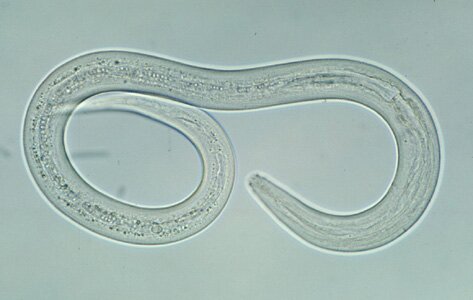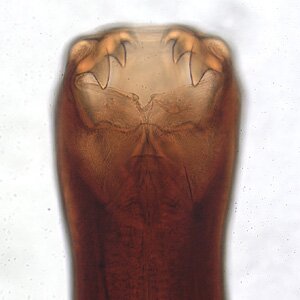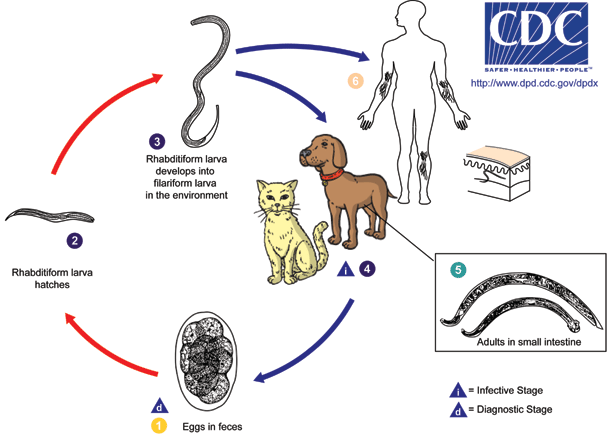Hookworm (Ancylostoma duodenale)

 Hookworm (Ancylostoma duodenale). Mature individuals are shorter than 2 cm and slightly pink. They live in the duodenum and causes a disease called ancylostomiasis. Ancylostomiasis is an invasive disease caused by nematodes of ancylostoma type. The main role in human pathogenesis is played by 2 species: hookworm and American hookworm. Ancylostomiasis is the most widespread parasite disease in a hot and worm climate e.i. Africa, South America, Asia, rarely in Europe. Larvas are hatched from eggs laid in the ground and can live there for a couple of weeks. In appropriate humidity they can get on the surface and attach to plants, stones, minning constructions, where they gather in large amounts. They are easily stimulated by human touch and are prone to chemical and thermal impulses so they can get into a human body through the skin and into the blood vessels. After passing the right side of the heart, larvas get into the bronchic cells, windpipe and throat. Swallowed larvas get into the small bowel where they grow up. Hookworms can live in a human organism for about 8 years. The penetration of invasive larvas through the skin causes itching and skin inflammations and its intensity depends on the larvas quantity and sensitivity of the man. A mature nematode sucks the blood while embedding in the mucosa. After its separation the bleeding doesn’t stop as a result of decrease in coagulability. The loss of blood can lead to serious anaemia. It can be accompanied by many symptoms regarding the alimentary and nervous system and physical deficiency in case of children.
Hookworm (Ancylostoma duodenale). Mature individuals are shorter than 2 cm and slightly pink. They live in the duodenum and causes a disease called ancylostomiasis. Ancylostomiasis is an invasive disease caused by nematodes of ancylostoma type. The main role in human pathogenesis is played by 2 species: hookworm and American hookworm. Ancylostomiasis is the most widespread parasite disease in a hot and worm climate e.i. Africa, South America, Asia, rarely in Europe. Larvas are hatched from eggs laid in the ground and can live there for a couple of weeks. In appropriate humidity they can get on the surface and attach to plants, stones, minning constructions, where they gather in large amounts. They are easily stimulated by human touch and are prone to chemical and thermal impulses so they can get into a human body through the skin and into the blood vessels. After passing the right side of the heart, larvas get into the bronchic cells, windpipe and throat. Swallowed larvas get into the small bowel where they grow up. Hookworms can live in a human organism for about 8 years. The penetration of invasive larvas through the skin causes itching and skin inflammations and its intensity depends on the larvas quantity and sensitivity of the man. A mature nematode sucks the blood while embedding in the mucosa. After its separation the bleeding doesn’t stop as a result of decrease in coagulability. The loss of blood can lead to serious anaemia. It can be accompanied by many symptoms regarding the alimentary and nervous system and physical deficiency in case of children.

Incoming search terms:
- Ancylostoma duodenale
- ancylostomiasis
- gambar ancylostoma duodenale
- ancylostoma duodenalis
- ancylostoma
- lifecycle of taenia solium
- hookworm
- anquilostoma duodenale
- anquilostoma
- strongyloides vs hookworm





